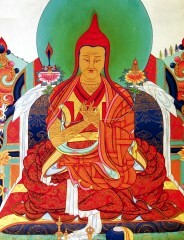Lost Buddhist Canon returned to Sakya Monastery in Tibet
June 17-- Tibetan Buddhist canon is a series of sacred texts recognized by various sects of Tibetan Buddhism. On June 11, a ceremony was held in the Sakya Monastery in Tibet to mark the purchase from overseas and donation of an excerpt of the Tripitaka (the Buddhist Canon).
Amid the resounding Tibetan Buddhism trumpet as part of the ritual, the monks and believers escorted the regained scripture to the main hall of the Sakya Monastery. Then the lamas put the precious scripture to the Sutra Wall in the monastery.
According to experts' evaluation, it was one chapter of the Kangyur manuscript written in Nepalese gold ink and donated by Emperor Yongle (1403-1424) in the Ming Dynasty.
Kangyur was part of the Tripitaka that contained the discourses attributed to Buddha Shakyamuni.
Kangyur consists of works supposed to have been said by the Buddha himself. All texts presumably have a Sanskrit original, although in many cases the Tibetan text was translated from Chinese or other languages.
The Kangyur is divided into sections on Vinaya, Perfection of Wisdom Sutras, Avatamsaka, Ratnakuta and other sutras, and tantras. When exactly the term Kangyur was first used is not known. Collections of canonical Buddhist texts already existed in the time of Trisong Detsen, the sixth king of Tibet. The exact number of texts in the Kangyur is not fixed. Each editor takes responsibility for removing texts he considers spurious or adding new translations. Currently there are about 12 available Kangyurs. These include the Derge, Lhasa, Narthang, Cone, Peking, Urga, Phudrak and Stog Palace versions, each named after the physical location of its printing (or copying in the case of manuscripts editions).
In addition, some canonical texts have been found in Tabo and Dunhuang which provide earlier exemplars to texts found in the Kangyur. The majority of extant Kangyur editions appear to stem from the so-called Old Narthang Kangyur, though the Phukdrak and Tawang editions are thought to lie outside of that textual lineage. The stemma of the Kangyur has been well researched in particular by Helmut Eimer and Paul Harrison.
The sutra's return was the efforts of Chen Feng, managing director of China's Tibet Culture Protection and Development Association and board chairman of the HNA Group (Hainan Airlines). He purchased the lost volume of the Buddhist Canon from overseas and donated it to the Sakya Monastery.
Chen highlighted the importance of this volume of sutra written in Tibetan language, stressing that the Tripitaka was a weighty Buddhist sutra in China and the reacquisition of this lost excerpt made the Kangyur complete as a crucial national treasure of Tibetan culture.
